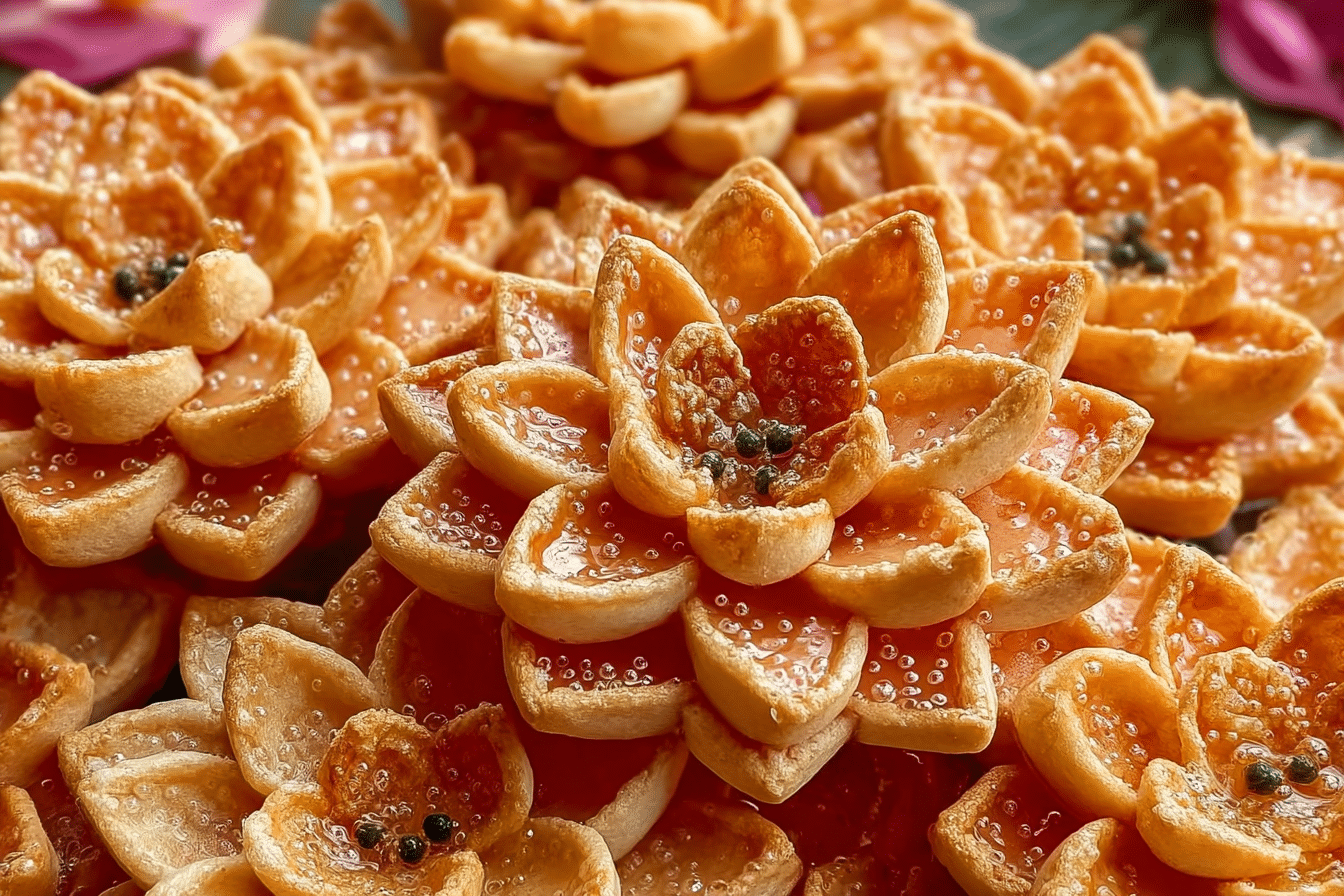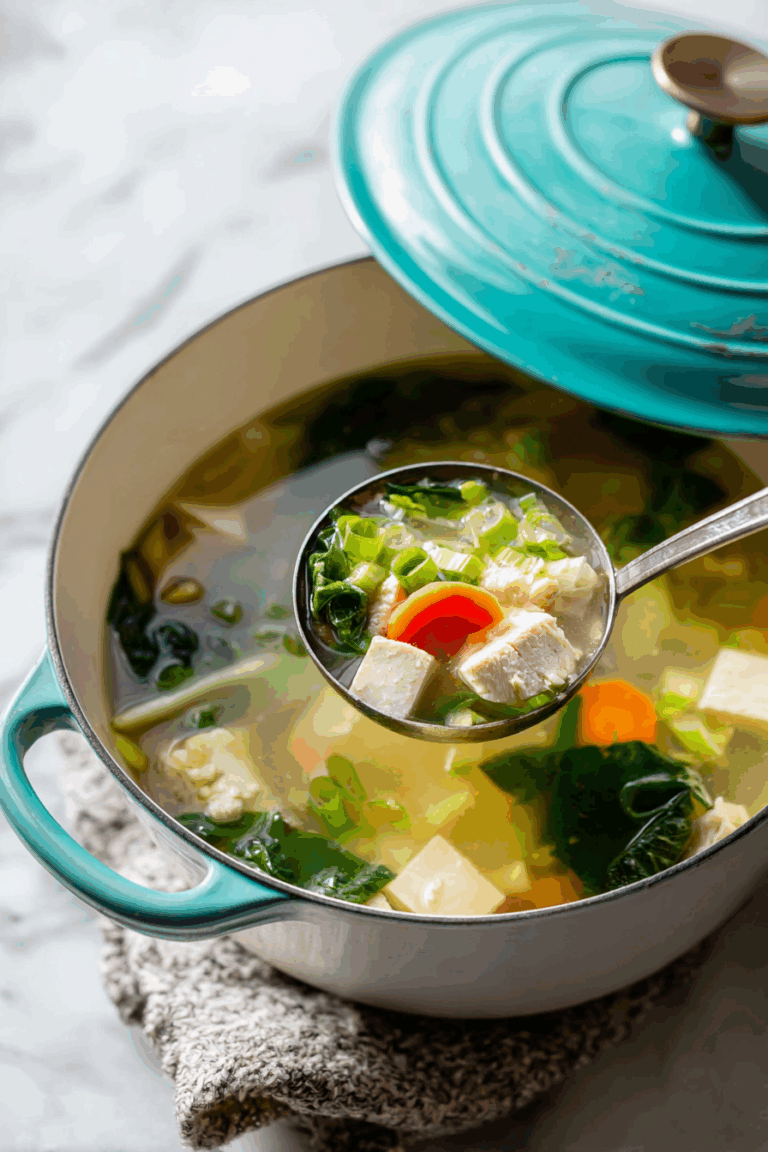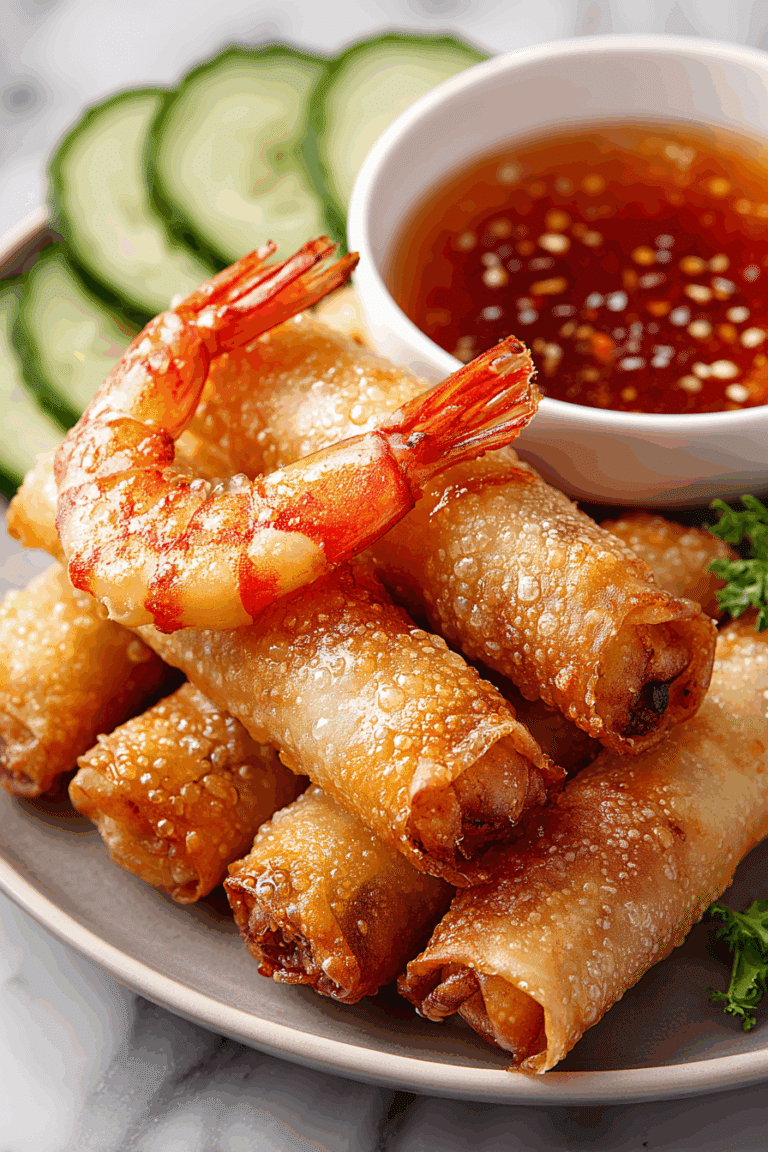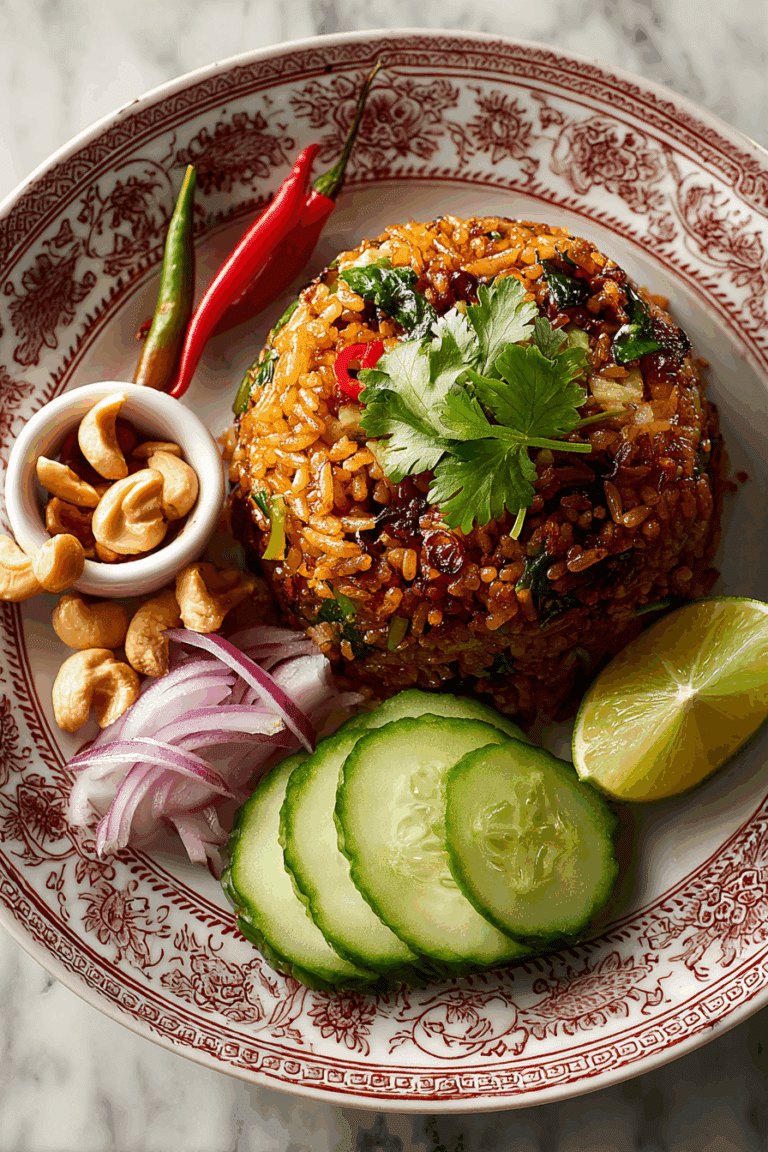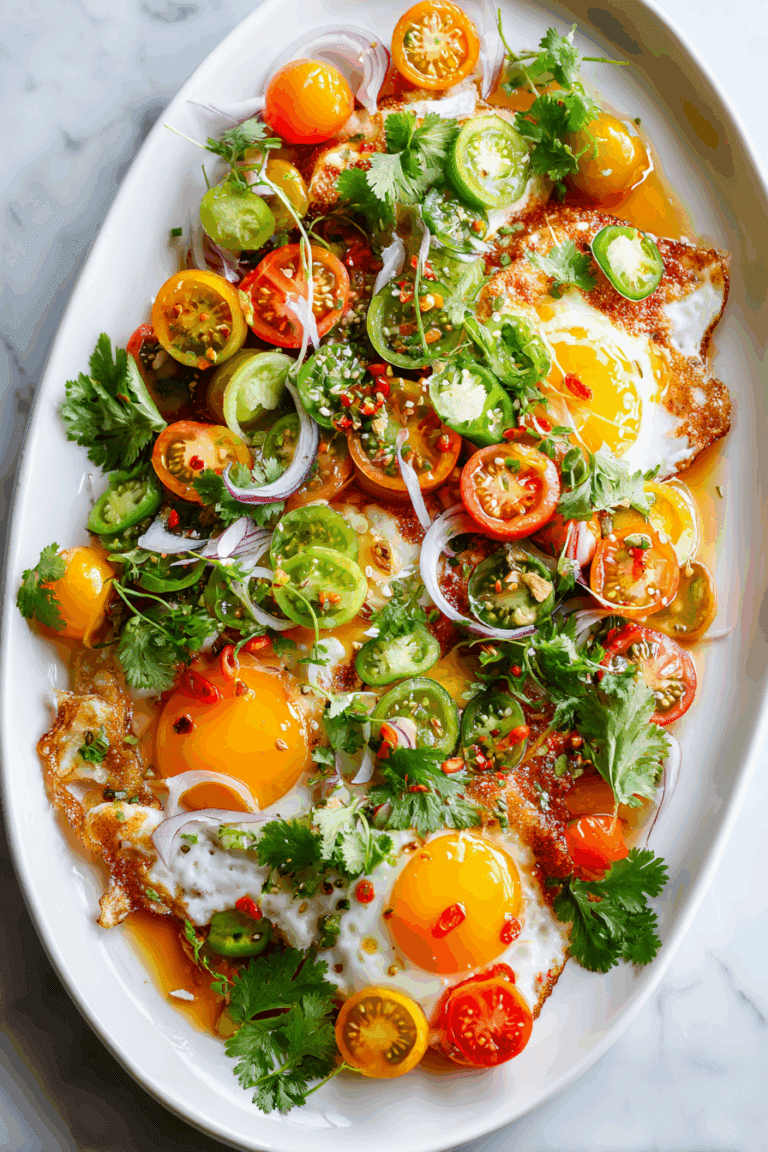How to Make Delicious Thai Lotus Flower Cookies
Thai Lotus Flower Cookies are one of those treats that make you stop for a moment and just admire how delicate food can be. The first time I saw them was in a tiny Bangkok market, where a woman was frying them in a wok, and the cookies bloomed like golden flowers in the bubbling oil. That moment inspired me to bring the recipe to Just Thai Recipes, where I share the foods that make Thailand’s kitchens so special.
When I first started Just Thai Recipes, it was meant to be a little corner of the internet to preserve the flavors I grew up with and the recipes my Thai friends and family taught me. Over time, it turned into a growing community of cooks and travelers who love discovering dishes like Pad Kra Pao, Mango Sticky Rice, and of course these Thai Lotus Flower Cookies. My goal is to keep these traditions alive, sharing easy steps that anyone can follow at home.
In this post, you’ll learn everything about making Thai Lotus Flower Cookies from scratch, including the right flour combination, frying technique, and even a few tips for shaping them perfectly. Whether you know them as Traditional Thai Lotus Flower Cookies or Kanom Dok Jok, they are crunchy, light, and slightly sweet with a lovely coconut aroma.
If you’ve ever searched for a Thai Lotus Flower Cookies recipe or wanted to recreate those golden blossoms you saw in a Thai market, this guide will walk you through every step. By the end, you’ll not only master the recipe but also understand the small cultural touches that make it so loved across Thailand and Laos.
Table of Contents
Table of Contents
Ingredients
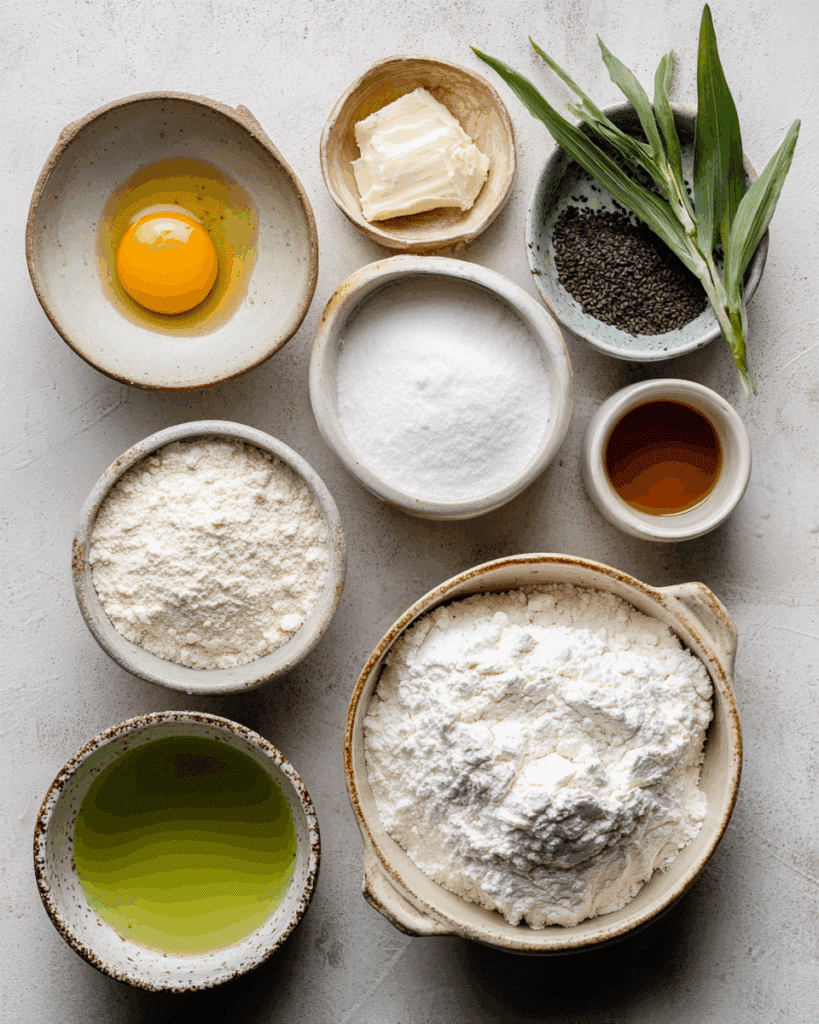
The ingredients for Thai Lotus Flower Cookies are simple, but the balance between them is what creates the perfect texture. Here’s what you need to prepare:
- 1 1/2 cups rice flour
- 1/2 cup tapioca starch
- 1/4 cup white sugar
- 2 tablespoons oil
- 1/2 teaspoon salt
- 1 duck egg (or a large chicken egg if you can’t find duck eggs)
- 1/2 cup lime water (see notes below)
- 1 cup coconut milk
- 2 tablespoons black sesame seeds
- 2 pandan leaves, roughly chopped
- Oil, as needed for deep-frying
If you’ve ever made Traditional Thai Cookies before, you might notice these ingredients are similar, but the secret lies in the lime water and coconut milk combination, which keeps the cookies crisp and light.
Notes and Swaps
- Rice Flour: Stick with Thai rice flour, which is finer than regular rice flour found in some supermarkets. You can find it in most Asian grocery stores or online.
- Tapioca Starch: This gives the cookies their signature crunch. Don’t skip it.
- Lime Water: This isn’t lime juice. Lime water is made by soaking a small piece of limestone in water until the water becomes slightly alkaline. It helps the cookies hold their shape and puff up beautifully during frying.
- Coconut Milk: Use full-fat coconut milk for the richest flavor. Shake the can before using.
- Duck Egg: It gives a slightly richer taste and crispier texture, but chicken eggs work too.
Before you start mixing, set aside all your dry ingredients in one bowl and your wet ingredients in another. This makes the process smoother and prevents overmixing later.
Step-by-Step Instructions
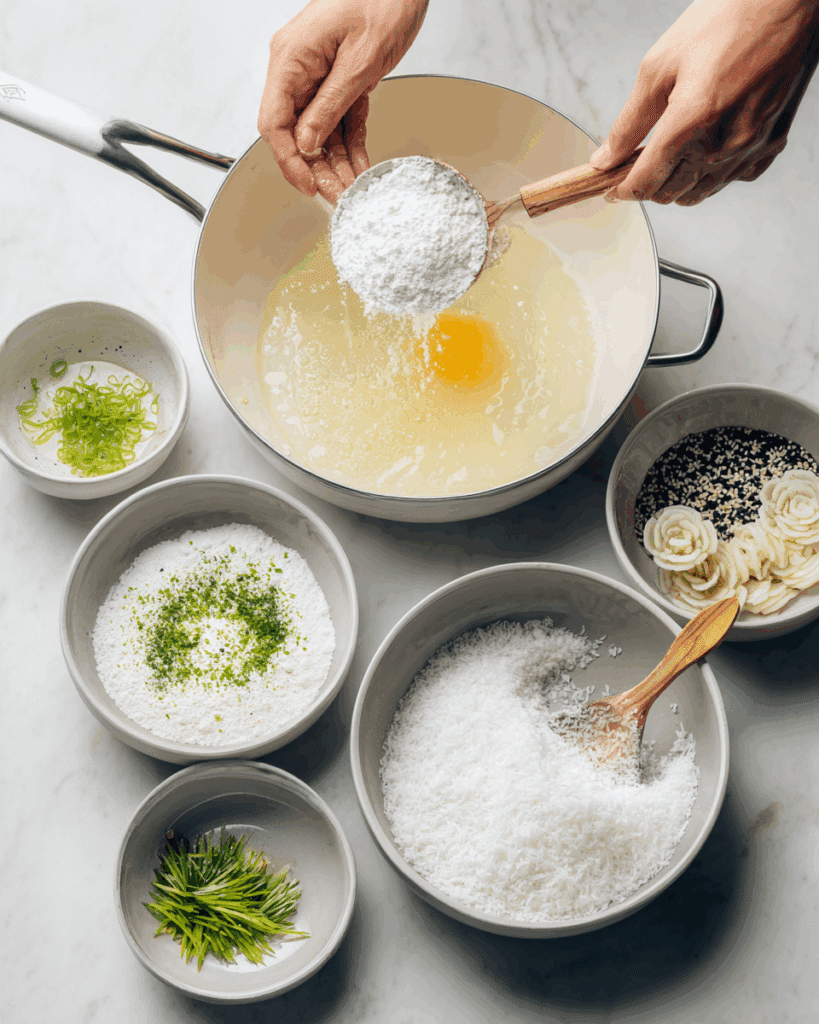
Now comes the fun part, where you turn a simple batter into beautiful, crisp cookies shaped like lotus flowers.
- Mix the Batter:
Place rice flour, tapioca starch, sugar, and salt in a large mixing bowl. Create a small well in the center. Crack in the egg, pour in the oil, lime water, and coconut milk. Start mixing slowly from the center, bringing in the dry ingredients bit by bit. Mix until smooth, then let it rest for about 10 minutes. - Strain the Batter:
To make sure your cookies are thin and crispy, pour the batter through a fine sieve into another bowl. This removes any lumps that might make the cookies heavy. - Add Sesame Seeds:
Stir in one tablespoon of black sesame seeds. Keep the rest for later so some cookies have a more speckled look. - Prepare the Oil:
Heat enough oil in a deep frying pan or wok. Add the chopped pandan leaves and fry them on low heat until fragrant. This step perfumes the oil and gives the cookies a subtle pandan scent. Remove the leaves once they start to brown. - Heat the Mold:
Before you start frying, place the metal lotus flower mold into the hot oil for a few seconds. When it’s hot enough, lift it out, shake off excess oil, and dip it into the batter just up to the edge, not covering the top. - Fry the Cookies:
Immediately dip the mold back into the hot oil. Hold it just above the bottom of the pan for about five seconds. Shake gently, and the cookie will release from the mold. Let it fry until golden, about 20 seconds on each side. - Shape and Cool:
Use tongs to remove the cookies and gently shape them over a small bowl to form petals. Once they cool, they’ll hold that shape beautifully. - Repeat and Enjoy:
Continue with the rest of the batter, reheating the mold each time. Serve the cookies warm or let them cool completely and store them in an airtight container.
If you want to see a detailed version of this frying method with step-by-step pictures, check out Thai Lotus Flower Cookies Recipe (Kanom Dok Jok) or Kanom Dok Jok, Thai Flower Cookie. Both sources explain how local Thai cooks achieve that perfect bloom in the oil.
Tips and Tricks
Making Thai Lotus Flower Cookies might look intimidating the first time, but once you get into the rhythm of heating, dipping, and frying, it becomes almost relaxing. Here are a few helpful tips I’ve learned after making dozens of batches.
1. Keep the Oil Temperature Consistent.
The key to crispy cookies that bloom perfectly is oil temperature. It should be hot enough for the batter to sizzle when dipped but not so hot that it burns before opening. I usually test with a small drop of batter. If it floats up and browns slowly, the temperature is right.
2. Reheat the Mold Between Batches.
Always keep the metal mold in the oil for a few seconds before dipping it into the batter again. A hot mold helps the batter stick at first and then release smoothly when placed back into the oil. If the mold cools down, the batter might not hold its shape.
3. Use Fresh Batter.
Letting the batter rest helps the starches absorb liquid, but don’t let it sit too long. After 30 minutes, it can start to thicken, which affects how the cookies crisp up. If it gets too thick, stir in a tablespoon of coconut milk to loosen it.
4. Add Sesame Seeds in Two Stages.
Mix half of the sesame seeds into the batter and sprinkle the other half on top of the cookies right before frying. It adds a nice layered look and gives extra crunch.
5. Store Correctly.
After frying, let the cookies cool completely on a wire rack before storing them. Moisture makes them lose their crunch quickly. Store them in an airtight container at room temperature. They can last for up to a week if kept dry.
6. Don’t Rush the Process.
This recipe isn’t hard, but it rewards patience. Give each cookie its moment in the oil, and don’t overcrowd the pan. The air around each cookie helps it bloom evenly, which gives you that delicate lotus shape.
Making Thai Lotus Flower Cookies is a bit of art and a bit of science. Once you get the rhythm right, you’ll see why so many home cooks and street vendors in Thailand love making them during festivals and family gatherings.
Variations
One of the best things about Thai Lotus Flower Cookies is that you can play with the flavors and presentation without losing their traditional charm. Here are a few creative ideas you can try next time.
Coconut Pandan Version
Add one teaspoon of pandan extract or a few drops of natural pandan juice to the batter. The cookies will take on a faint green tint and a lovely floral aroma. In Thailand, this version is popular at temple fairs and often served with hot tea.
Sweet and Spicy Version
If you like the balance of sweet and savory, sprinkle a tiny pinch of chili powder on the cookies right after frying. It might sound unusual, but that little kick pairs beautifully with the coconut flavor.
Sesame and Honey Glaze
After frying, drizzle a small amount of warm honey mixed with sesame seeds on top of the cookies. This variation is common in parts of Laos, where they like a touch of sticky sweetness on traditional desserts.
Chocolate Dip
For a modern twist, dip half of each cooled cookie into melted dark chocolate. Let them harden on parchment paper. This mix of Thai texture and chocolate flavor is perfect for serving at parties or as gifts.
Flower Shapes for Kids
If you’re making these with children, use smaller molds and let them sprinkle colored sugar on top. It’s not traditional, but it’s a fun way to introduce them to Thai sweets.
The beauty of these cookies is that they welcome creativity. Whether you keep them classic or give them a modern flavor twist, they always look stunning and taste even better.
Nutrition and Health Benefits
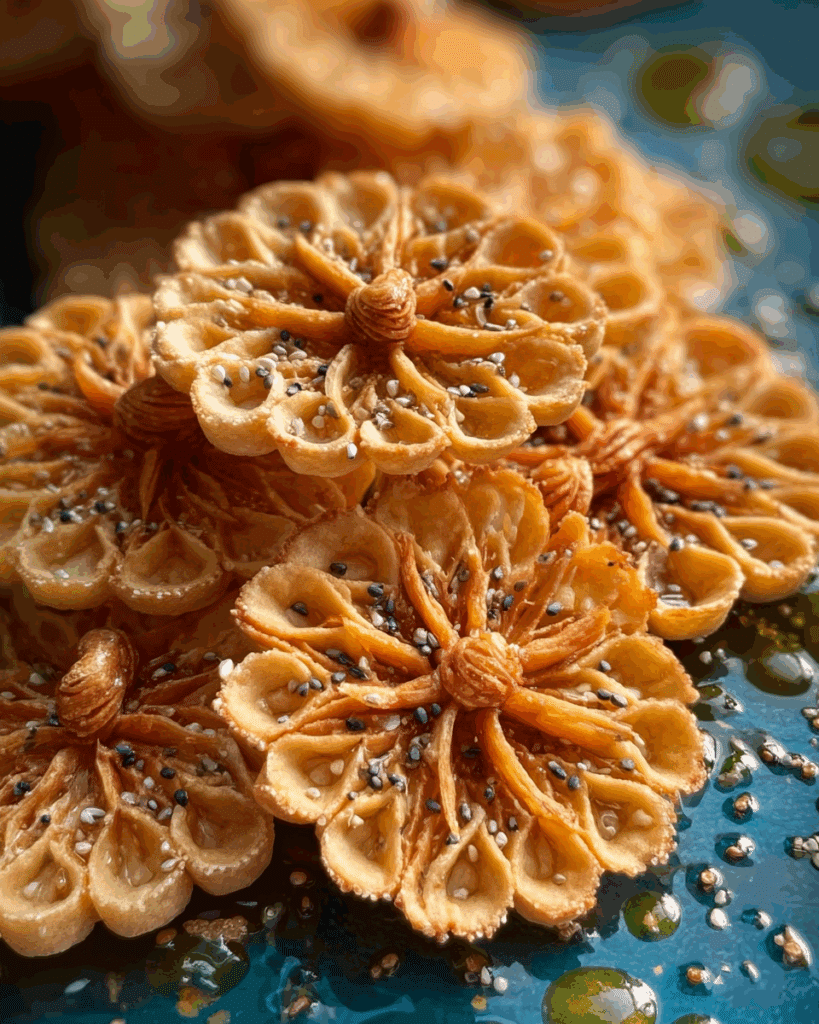
Even though Thai Lotus Flower Cookies are a deep-fried treat, they’re not heavy or greasy when made properly. A few cookies can satisfy your craving for something sweet without feeling overwhelming.
Here’s a rough nutrition breakdown per cookie (depending on size and thickness):
- Calories: 70–90
- Carbohydrates: 10–12 grams
- Fat: 3–5 grams
- Protein: 1–2 grams
- Sugar: 3–4 grams
The coconut milk provides healthy fats, and the sesame seeds add a small boost of minerals like calcium and magnesium. Compared to Western cookies, these Thai cookies are surprisingly light and lower in refined fat, which makes them a lovely snack with tea or coffee.
If you want to make a slightly lighter version, you can try baking instead of deep-frying, though the texture won’t be as crisp. Alternatively, use an air fryer at 375°F for 5–6 minutes, checking often until they turn golden.
Traditional Thai sweets often balance natural ingredients like coconut, rice, and sesame. These cookies are no exception. They are made with simple pantry staples that are gluten-free and dairy-free, which makes them suitable for many diets.
When served fresh, they capture everything Thai desserts are known for light sweetness, aromatic flavors, and beautiful presentation.
Make-Ahead, Storage, and Freezing
If you’re planning to make Thai Lotus Flower Cookies for a special event or holiday, preparing ahead is easy.
Make-Ahead:
You can mix the dry ingredients a day before and store them in an airtight container. On the day of cooking, simply combine with the wet ingredients to make fresh batter. Avoid preparing the batter too early since coconut milk can separate and change texture.
Storage:
After frying, let the cookies cool completely. Then layer them gently in a tin or airtight box lined with parchment paper. Keep them away from moisture, since humidity can soften them quickly.
Freezing:
You can freeze the raw batter for up to one month. Thaw it overnight in the refrigerator, stir well, and strain again before using. You can also freeze cooked cookies, though they may lose a bit of crunch. To re-crisp them, place in a 300°F oven for 3–4 minutes.
Reheating:
If you want to enjoy the cookies warm, heat them briefly in the oven instead of the microwave. Microwaving adds moisture, which makes them soft.
Whether you’re preparing them for a festival, a family tea, or simply to enjoy with coffee, these cookies store beautifully and bring joy every time you open the container.
Common Mistakes to Avoid
Even experienced cooks make a few errors when preparing Thai Lotus Flower Cookies. They look simple, but a small change in oil temperature or batter texture can make a big difference. Here are the most common mistakes and how to fix them.
1. Batter Too Thick or Too Thin.
If your batter is too thick, the Thai Lotus Flower Cookies will turn heavy and won’t crisp evenly. Add a little coconut milk to thin it until it coats the back of a spoon. On the other hand, if it’s too thin, the cookies will break apart in the oil.
2. Cold Mold.
A cold mold prevents the batter from sticking properly. Always heat the mold in the oil before dipping it. When it’s hot enough, the batter will sizzle gently and form perfect petals, just like true Thai Lotus Flower Cookies from the markets in Bangkok.
3. Overcrowding the Pan.
Adding too many cookies at once lowers the oil temperature. The result is greasy Thai Lotus Flower Cookies that lose their crispness. Fry in small batches to keep them light.
4. Forgetting to Rest the Batter.
Resting allows the flour and starch to hydrate. If you skip this step, the cookies won’t puff beautifully. Rest for at least ten minutes before frying.
5. Not Storing Properly.
Humidity is the enemy of crispy Thai Lotus Flower Cookies. Always cool them completely before storing in airtight containers with parchment between layers.
These little details separate good Thai Lotus Flower Cookies from great ones. Once you learn from these mistakes, you’ll be able to create batches that stay crisp for days.
Cultural or Historical Background
The history of Thai Lotus Flower Cookies, or Kanom Dok Jok as they are called in Thai, goes back generations. The word Dok Jok literally means “flower pattern,” which perfectly describes the shape of these cookies. They are believed to have originated in central Thailand, where women used to prepare them for temple offerings and festive celebrations.
In old Thai culture, the lotus flower is sacred and symbolizes purity and enlightenment. Making Thai Lotus Flower Cookies in the shape of a lotus was considered a respectful offering to monks during Buddhist ceremonies. The crisp petals represented beauty and delicacy, two traits admired in traditional Thai craftsmanship.
Through time, these cookies became a household treat enjoyed during the New Year and Songkran Festival. Families gather in kitchens, heat up large woks, and take turns dipping molds into the batter. The scent of frying sesame and coconut fills the air, and the sound of sizzling batter brings a sense of joy and community.
In some parts of Laos, a similar treat called Kha Nom Dok Jok Lao shares the same roots. The process is nearly identical, showing how food travels and connects cultures. Today, Thai Lotus Flower Cookies are not only a nostalgic snack but also a beautiful symbol of Thai heritage.
If you walk through any Thai food market, especially in provinces like Ayutthaya or Chiang Mai, you will see vendors frying golden Thai Lotus Flower Cookies in large pans. They stack them high in baskets, their intricate patterns catching the sunlight. Many tourists buy them as edible souvenirs because they last long and carry the taste of authentic Thailand.
These cookies are a bridge between the past and present. When you make Thai Lotus Flower Cookies at home, you take part in a culinary tradition that has survived for centuries.
Serving Suggestions
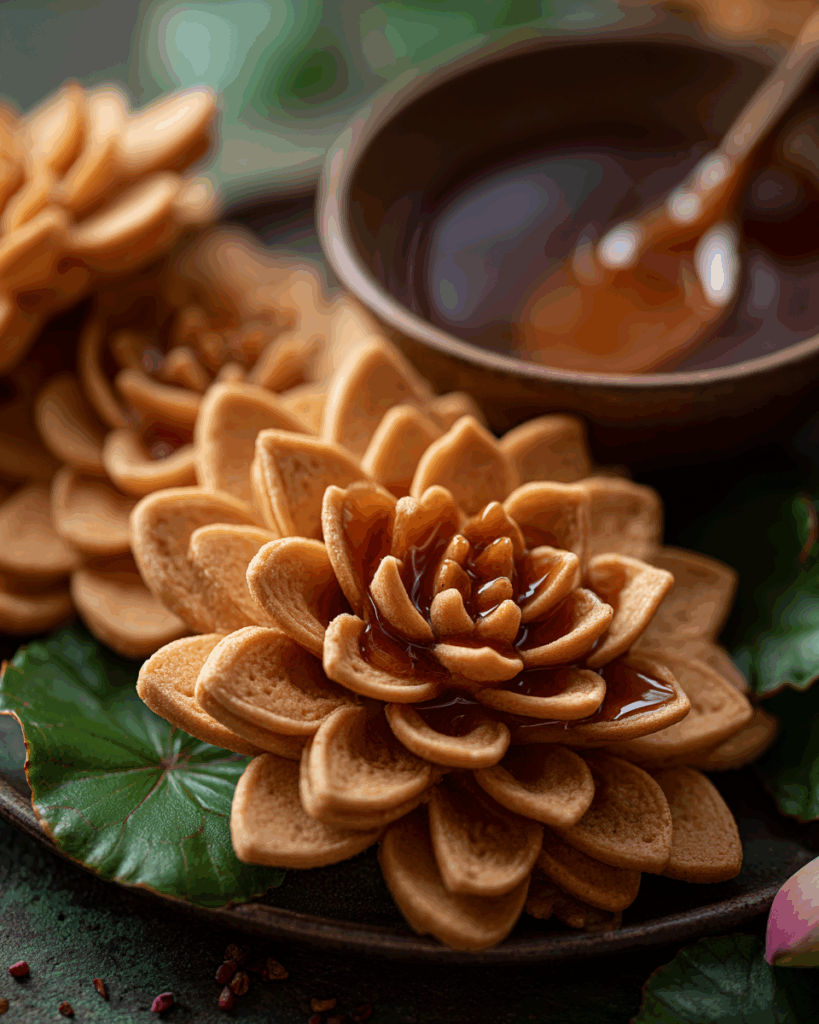
The best part about Thai Lotus Flower Cookies is how versatile they are. They can be a snack, a dessert, or even a charming gift. Here are some ways to serve them so they shine in every situation.
1. Traditional Thai Way.
In Thai homes, Thai Lotus Flower Cookies are usually served with hot tea or coffee in the afternoon. The light sweetness complements the bitterness of tea perfectly. Arrange them on a small woven tray lined with banana leaves for an authentic presentation.
2. With Tropical Fruits.
Pair the cookies with slices of mango, pineapple, or papaya. The fruit adds a juicy contrast to the crisp cookies. You can even serve them alongside [Internal Link: Thai Mango Sticky Rice] for a full Thai dessert platter.
3. As a Gift.
Because Thai Lotus Flower Cookies hold their shape so beautifully, they make wonderful edible gifts. Place them in clear jars with ribbons or small boxes lined with paper. Many people in Thailand give them as thank-you treats during the holidays.
4. Ice Cream Topping.
Crush a few Thai Lotus Flower Cookies and sprinkle them over coconut ice cream. The crunchy texture and nutty sesame flavor make it irresistible.
5. Party Snacks.
Serve them alongside Thai Iced Tea or Thai Coffee for a themed gathering. Their delicate shape always starts conversations and brings a touch of elegance to any dessert table.
Whether you serve Thai Lotus Flower Cookies in a traditional tea setting or as part of a modern dessert board, their beauty always stands out. Their golden color, intricate lotus design, and subtle coconut scent make them more than just a cookie. They are a piece of Thai art that you can eat.
When people look for Thai Lotus Flower Cookies, they often explore similar recipes that celebrate Thailand’s delicate desserts and temple-style sweets. Searches such as traditional Thai lotus flower cookies, Thai lotus flower cookies recipe, Lao lotus flower cookies, traditional Thai cookies, and lotus flower cookies recipe often lead to new favorites.
Many curious cooks compare Thai Lotus Flower Cookies to other crispy Thai snacks like Khanom Buang or Thong Muan. These treats share the same spirit of light, crunchy texture that pairs so well with tea or coffee. The phrase lotus flower cookie crk sometimes appears in searches from fans of gaming who discovered the cookie through online culture and later fell in love with the real food itself.
Other people want to know how Thai Lotus Flower Cookies connect to the Lotus Flower Cookies Percy Jackson reference, which became popular because of the mythical lotus that made travelers forget time. The Thai version, however, is far sweeter and much more inviting.
When you dive into this kind of search, you notice a pattern. People are drawn not only to the taste of Thai Lotus Flower Cookies but also to their story. They are a piece of culture you can make in your kitchen, which makes them both a food and a memory.
Conclusion
Making Thai Lotus Flower Cookies is more than following a recipe. It is a small act of patience and creativity that brings a touch of Thai tradition into your home. The moment you dip the mold into the hot batter and watch the cookie bloom, you understand why these cookies are loved across generations.
Every step, from mixing the rice flour and coconut milk to shaping the cookies into delicate flowers, tells a story of craftsmanship and care. The aroma of sesame and pandan fills the kitchen, reminding you of the markets in Thailand where vendors fry golden cookies in wide woks while chatting with customers.
If you try this recipe once, you might find yourself coming back to it again and again. Thai Lotus Flower Cookies are perfect for family gatherings, gifts, or simply as a peaceful afternoon snack. They hold the magic of something handmade and remind us that good food doesn’t always need fancy tools or complicated steps.
FAQ
What makes Thai Lotus Flower Cookies special?
They are special because of their shape and texture. The lotus design represents purity in Thai culture, and the cookies are both light and fragrant with coconut and sesame. Few snacks look as beautiful as freshly fried Thai Lotus Flower Cookies.
Can I use a chicken egg instead of a duck egg for Thai Lotus Flower Cookies?
Yes, you can. Duck eggs give a richer flavor, but chicken eggs work just as well. The texture of the cookies remains crisp if the oil temperature is right.
How do you keep Thai Lotus Flower Cookies crispy?
Let the cookies cool completely before storing them. Keep them in an airtight container in a dry place. If they soften, place them in a warm oven for a few minutes to regain crispness.
What are Thai Lotus Flower Cookies made of?
Thai Lotus Flower Cookies are made from rice flour, tapioca starch, sugar, coconut milk, and black sesame seeds. The batter is dipped using a flower-shaped mold and fried until golden and crisp.
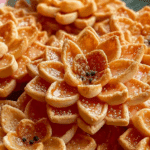
Thai Lotus Flower Cookies
- Prep Time: 10 minutes
- Cook Time: 15 minutes
- Total Time: 25 minutes
- Yield: 25 cookies 1x
- Category: Dessert
- Method: Deep-Frying
- Cuisine: Thai
- Diet: Gluten Free
Description
Thai Lotus Flower Cookies, also known as Kanom Dok Jok, are delicate, crispy Thai cookies made from rice flour, tapioca starch, and coconut milk. They are shaped like blooming lotus flowers and fried until golden and fragrant with sesame and pandan.
Ingredients
- 1 1/2 cups rice flour
- 1/2 cup tapioca starch
- 1/4 cup white sugar
- 2 tablespoons oil
- 1/2 teaspoon salt
- 1 duck egg
- 1/2 cup lime water (see notes)
- 1 cup coconut milk
- 2 tablespoons black sesame seeds
- 2 pandan leaves, roughly chopped
- Oil, as needed for deep-frying
Instructions
- Place rice flour, tapioca starch, sugar, and salt into a large mixing bowl. Create a well in the center and add the egg, oil, lime water, and coconut milk. Stir gradually, incorporating the dry ingredients until smooth. Let the batter rest for 10 minutes.
- Strain the batter through a fine sieve into another bowl to remove lumps.
- Stir in 1 tablespoon of black sesame seeds. Add the second tablespoon after using half the batter.
- Heat oil in a deep frying pan or wok. Fry the chopped pandan leaves over low to medium heat until aromatic, then remove them.
- Preheat the lotus flower mold in the hot oil for a few seconds. Lift it out and tap gently on paper towels to remove excess oil.
- Dip the heated mold into the batter for 3 counts, ensuring not to cover the top. Shake off excess batter and return the mold to the hot oil immediately.
- Submerge the mold just above the bottom of the pan for about 5 counts. Shake gently to release the cookie from the mold.
- Fry each cookie for about 20 seconds, flip, and fry another 20 seconds until golden brown. Remove with tongs.
- Shape the fried cookie over a small bowl to form the lotus flower shape. Continue with remaining batter, reheating the mold as needed.
- Transfer finished cookies to a colander to drain oil. Serve warm or store in an airtight container once cooled.
Notes
- Use full-fat coconut milk for the best flavor and crisp texture.
- Lime water is made by soaking limestone paste in water until clear; only use the clear water.
- Keep the lotus mold hot between uses to ensure cookies release properly.
- Store cookies in a dry, airtight container to maintain crispness.
- Duck eggs create a richer flavor, but chicken eggs are an acceptable substitute.
Nutrition
- Serving Size: 1 cookie
- Calories: 80
- Sugar: 3g
- Sodium: 40mg
- Fat: 4g
- Saturated Fat: 2g
- Unsaturated Fat: 1.5g
- Trans Fat: 0g
- Carbohydrates: 10g
- Fiber: 0.5g
- Protein: 2g
- Cholesterol: 10mg
Keywords: Thai Lotus Flower Cookies, Kanom Dok Jok, Thai Desserts, Traditional Thai Cookies, Coconut Milk Cookies, Crispy Thai Snacks, Lao Lotus Flower Cookies, Thai Festival Sweets, Lotus Flower Cookies Recipe

